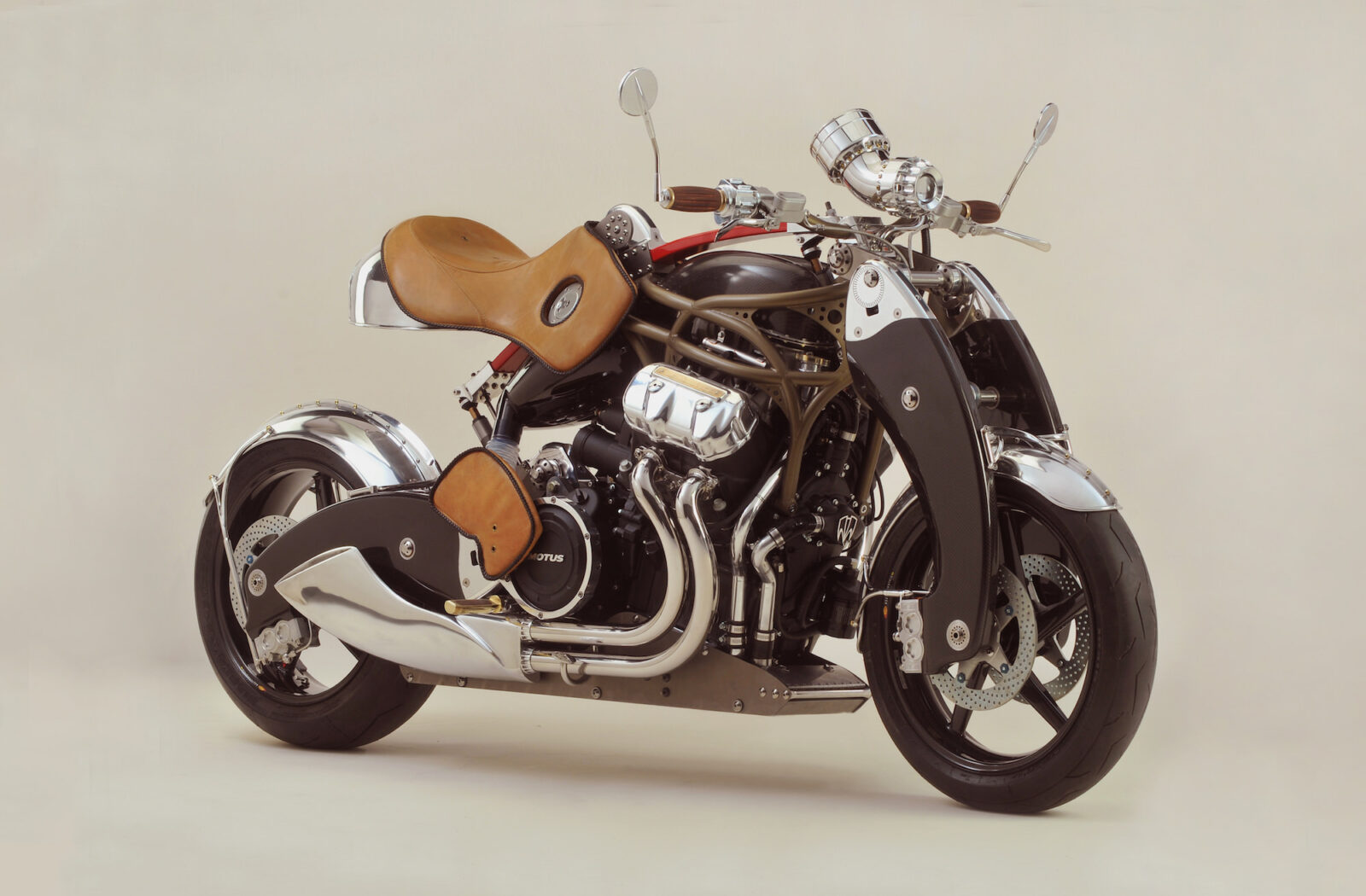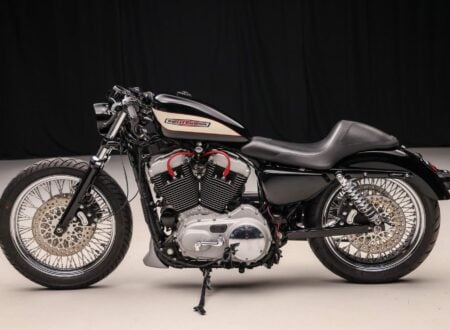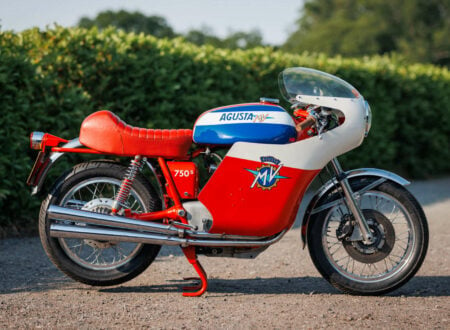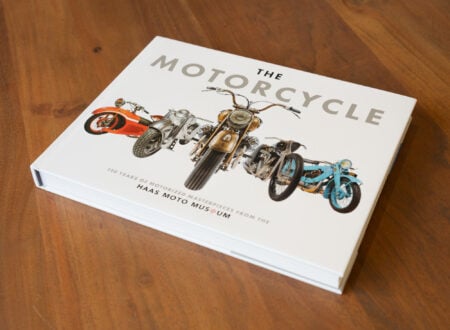– This article is a conversational interview of motorcycle and car designer JT Nesbitt by Jason Cormier –
“So tell me what you think, man.”
JT is wearing a shit-eating grin and holding a tallboy of Coors. He’s beaming because today is the first time his incredible creation has been rolled out of his New Orleans workshop into the public eye. I’m standing outside the Motus factory in downtown Birmingham, Alabama on a warm fall evening in October 2013. I’m barely able to process what I’m seeing, let alone formulate any meaningful opinion about it.
I recall my immediate reaction as being “What the fuck does it matter what I think?”
The thought comes in a moment of pure intensity for me. It followed a long, difficult day spent running around in muggy Southern heat while attending the Barber Vintage Festival. I’ve dragged myself here to meet the man who I’ve been following and conversing with for several months, an enigmatic and controversial motorcycle designer who has been keen to share his ideas with me. Today is the day his baby gets unveiled to the public. This marks the first time I’ve met JT Nesbitt in person, and it’s the first time I’ve seen his handiwork outside of a computer screen. And I’m completely awestruck.
I wasn’t the only one. That evening Pierre Terblanche, Miguel Galuzzi, Alan Cathcart and several other motorcycle industry celebrities made appearances at the Motus factory to check out Nesbitt’s latest mad creation. Cathcart was so taken by the machine that he cancelled a dinner engagement and called his photographer in to do an impromptu interview and photo session on the factory floor.
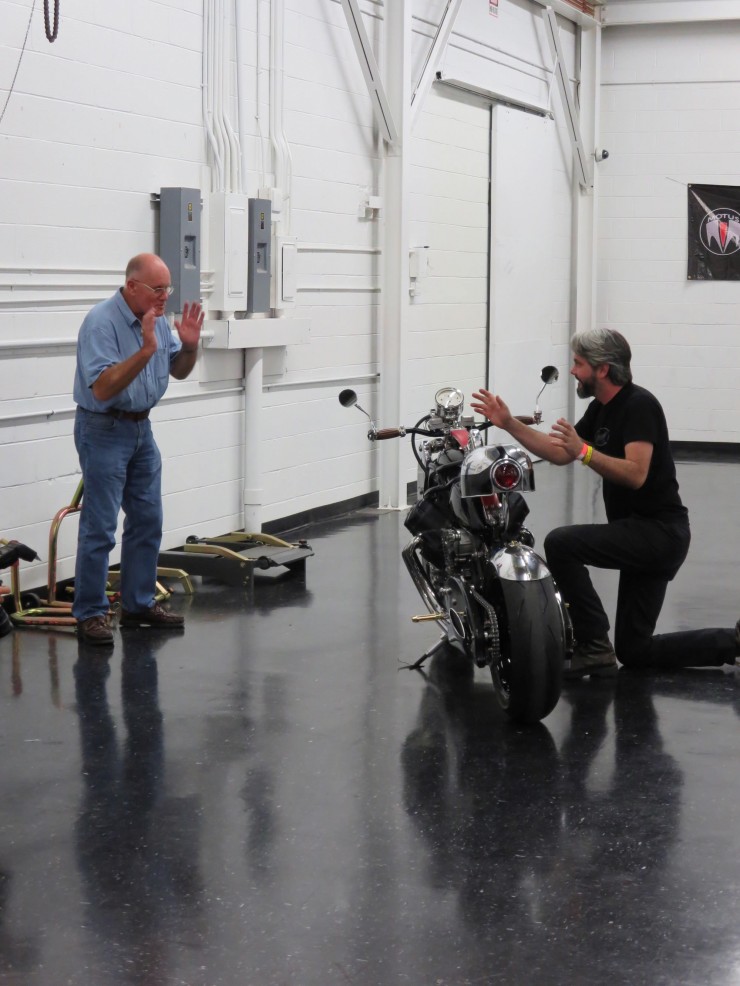
The machine in front of us that evening was the pre-production prototype of the Bienville Legacy. It was the culmination of many years of thought and hard work on Nesbitt’s part, and the generosity of a singular organization called the ADMCi, and it was utterly astonishing. My introduction to this machine left a deep impression on me. Here was a machine that completely obliterated any pre-conceived notions of what would constitute the chassis and suspension design of a motorcycle, and did so in spectacular fashion with some of the most intricate workmanship you will see this side of the jewellery industry.
There was no need to give my opinion. This motorcycle was spectacular. It was ridiculous. It was so unlike anything I had seen before that it was hard to comprehend. I knew this machine had great significance, perhaps even more than I realized at that moment – here was not just a design that defied convention in nearly every aspect, but it was also the product of a program of sponsorship that represented a new way of conceiving of craft production in America.
Exactly one year later Nesbitt and the staff of the ADMCi unveiled three complete machines at the Barber Vintage Festival, and once again proudly showcased the Legacy at the Motus Motorcycles factory in downtown Birmingham. I was fortunate enough to be present at the unveiling of the finished machines and to once again spend some time with Nesbitt and his ADMCi entourage. Now that the completed Bienville Legacy has been unleashed upon the world, it seems an appropriate time to interview Mr. Nesbitt and get his thoughts now that the project had been completed.
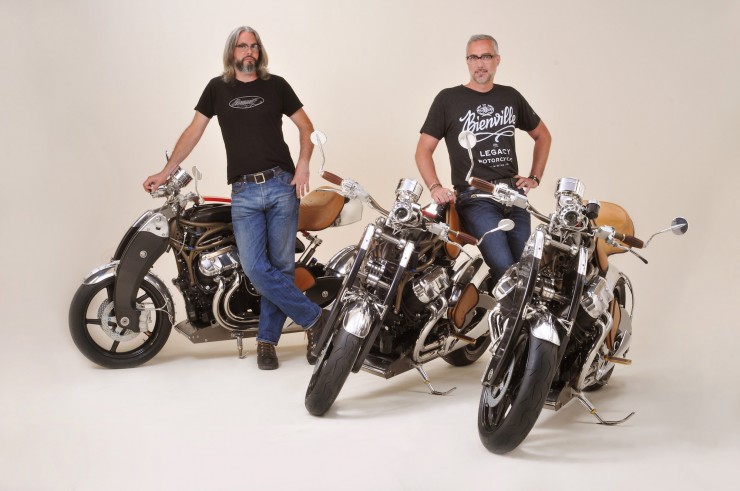
JT Nesbitt and Bienville Studios
JT is an enigmatic and fascinating player in the motorcycle industry. He is outspoken and uncompromising – sometimes a bit arrogant, but always honest and perceptive. He openly flaunts convention and refuses to abide by the arbitrary rules laid out within the motorcycle industry. His iconoclastic work has garnered more attention, good or ill, than his apparently marginalized position would allow. He is a motorcycle designer, but not one that abides by any conventional definition of the position – his work exhibits none of the compromises that most industrial designers are forced to abide by. Traditional designers tend to view him as more of an artist than a member of their ranks, but he refuses to identify as one.
“I suppose that from the very beginning it has been a struggle to define the odd place that I have occupied. Making motorcycles in Louisiana does seem a bit improbable. From my father’s condemnation of my motorcycle fascination at age 14, the near expulsion from college threatened by my professors for the same offence, and for the past couple of decades, not much more than a confused reaction from the majority of locals.
My first big break came with Iron Horse Magazine. Its potency can still be felt some 25 years after David Snow assumed the position of Editor-In-Chief. He, more than any other, is responsible for the explosion of underground, hardcore, minimalist custom motorcycles that we take for granted today. Back then there was only a small group of guys working in that vein, and for whatever reason, he allowed me to contribute to Iron Horse as a columnist and reporter – For no money of course… But the lack of pay never mattered. Snow was the first person to ever care about what I had to say about motorcycles and I don’t think that he has ever been given enough credit by American motorcyclists at large or by me in particular. David Snow is a very special person, and not forgotten by those who were there.”
Any discussion of Nesbitt’s work inevitably must include a nod to his days at Confederate, where he worked from 2000 to 2005. While there he designed two of the company’s most iconic motorcycles, the G2 Hellcat and the Wraith.
“Needless to say, discovering Confederate Motorcycles in 1994 was a revelation and I knew that I had to be a part of the team that founder Matt Chambers had created. His vision for a rediscovery of industrial heritage was the most powerful message that I ever heard. Matt was an avid fan of Iron Horse Magazine (a guilty pleasure for many in the industry) and knew a little about my work for Snow.
My chance finally came in 2000 when the company was in Chapter 11 and I was able to get my foot in the door. There wasn’t exactly a line of folks waiting for interviews for jobs that were not guaranteed pay. It was, however, a great place to prove my passion. Lack of experience and talent at that point were secondary to fervent desire to be a part of something special and I think that Chambers found that enough of a reason to keep me around.
The subsequent painful reorganization of Confederate led to the move to New Orleans and a flourishing of new ideas about motorcycle design. I had assumed the role of designer/project manager, but also worked on the production line, human resources, delivery driver, floor sweeper, etc. I don’t think that I ever made more than minimum wage considering all of the extracurricular hours, but it didn’t matter… I was having the time of my life and allowed a tremendous degree of autonomy by Matt.
Confederate was well on the path to recovery with a two model line-up. The G2 Hellcat was a solid seller and the original concept and two prototype Wraiths were generating tremendous interest and press thanks mainly to Alan Cathcart, who really wanted us to succeed.
Katrina changed everything. With the factory completely destroyed in 2005, Matt did what he felt was best for the company, a move to Birmingham. I stayed in New Orleans and suffered greatly for that decision. I cleaned bathrooms, bartended, waited tables, was a barker on Bourbon Street.
While in the ‘wilderness,’ I dedicated my free time to resuming my love affair with cars. I have done some pretty interesting projects, but let’s stay on topic – the work presented here, nine years after losing everything… Nine years of planning, sketching, waiting, for just the right conditions to build and present the next motorcycle.
Once again, it is worth note that I am not being paid to build these three motorcycles. I think that it is fair to say that I have been doing more, with less, for a long time.
Rubbing two sticks together to make motorcycles has, however, been great training… It is the difference between a zealot and a mercenary; feel free to decide which category should be mine.”
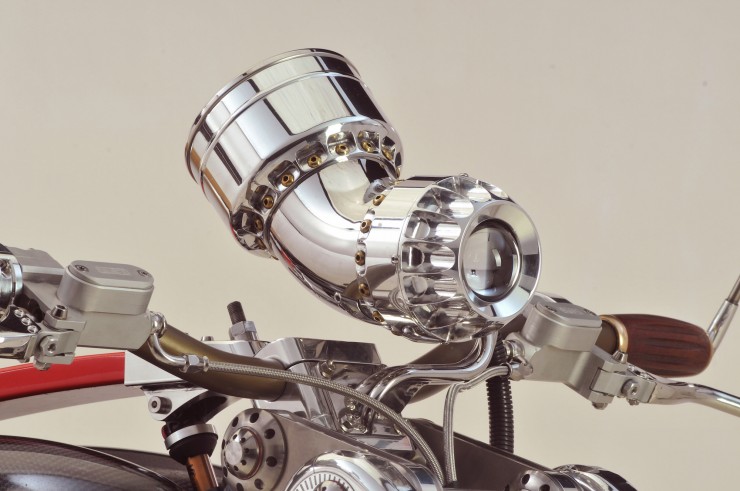
Nesbitt likes to play up his current projects while downplaying his past work. He is a man who is always looking forward. He likes to say his best design is his next design, while waving away inquiries into his past work. During those days in the “wilderness” he managed to open Bienville Studios in the heart of the iconic French Quarter of New Orleans and work on a series of remarkable projects. His portfolio following his departure from Confederate was as eclectic as it was fascinating – he designed a Bowie knife, reimagined the LeMat revolver, rebuilt a Katrina flood damaged Lincoln Mark VIII into a Bonneville contender, and scratch built a stunning natural-gas powered roadster he called the Magnolia Special which he and Maxwell Materne drove from New York to Los Angeles in a record 89 hours. His design for a new motorcycle that would follow up on his work at Confederate was relegated to the drawing board and his sketchbook while he took the time to experiment with other projects.
A man like Nesbitt doesn’t have a traditional set of idols. His inspirations and his heroes are varied but all follow what he perceives to be the purest goal: uncompromising ideals that are uncorrupted by commercial considerations.
“My heroes are the true Zealots. Mostly they are not household names because their contributions were never rewarded with fortune. I can definitely sympathize with those toiling in relative obscurity, finding it a thrill being fortunate enough to be asked these questions currently.
Of those names that we do know, Horacio Pagani is the first to mind. The misconception that he is a rich guy building cars for rich guys belies an understanding of his resume and the reality of boutique manufacturing. He must project an aura of confident stability for marketing reasons, but having a little experience in that world myself, I suspect that it is much more hand-to-mouth. Focusing on product rather than financial instruments pretty much means taking a vow of poverty and Horacio’s cars are a direct line to this philosophy. They are an inspiration. Sitting in a Zonda puts me in SUCH a special place, reverence and awe. Probably the closest to a spiritual experience as I have ever had.
John Britten’s motorcycle is equally as compelling. I think that it is safe to say that my design heroes are the ones whose work makes me antsy to get back to work. I simply can’t be in the presence of a V-1000 for very long before the urge to make something sends me back to the studio.
Equally, Norbert Riedel’s Imme inspires with its astoundingly beautiful economy of design and is truly a function of its post-war austerity.
The beauty of the French coachbuilders Figoni et Falaschi, DeVillars, Henri Chapron, Saotchik, Vanvooren, etc…
The risk-taking by the Italian coachbuilders: Pininfarina, Boano, Vignale, Touring, Fantuzzi, Scaglietti, Bertone, etc….
The perfection of function of the guns of John Moses Browning…
The ever-irascible Enzo Ferrari, combative and forceful, always playing the game by his own rules, the passion for the cars that bear his name is unmatched….
The near religious dedication of the Hizen tradition of Japanese sword smiths led by the Tadayoshi…
Ettore Bugatti mastered the art of a perfect life, and the work is so thoroughly imbued with that beauty…
All of these works have one thing in common- They are contextual. They are more than objects, and have transcended to become icons for a CULTURE. A representation of the thoughts and aspirations of a specific set of people, yet inevitably a product of individual and uncompromising vision.
That means that I can’t re-hash motorcycles from a time and place that has no direct connection with my culture, it would be dishonest. With that in mind, I have made it my life’s work to contribute to an understanding of what a Louisiana motorcycle should be, starting from first principles, guided by the whispers of the Titans, living and long dead.”
The Motorcycle Industry
Nesbitt’s list of zealots is noticeably devoid of icons of motorcycling. His work has led him to projects in what are traditionally two disparate industries which often see very little crossover – motorcycles and automobiles. As a man who has experimented in both fields, he has formulated a unique perspective on the differences between motorcycle and automotive culture.
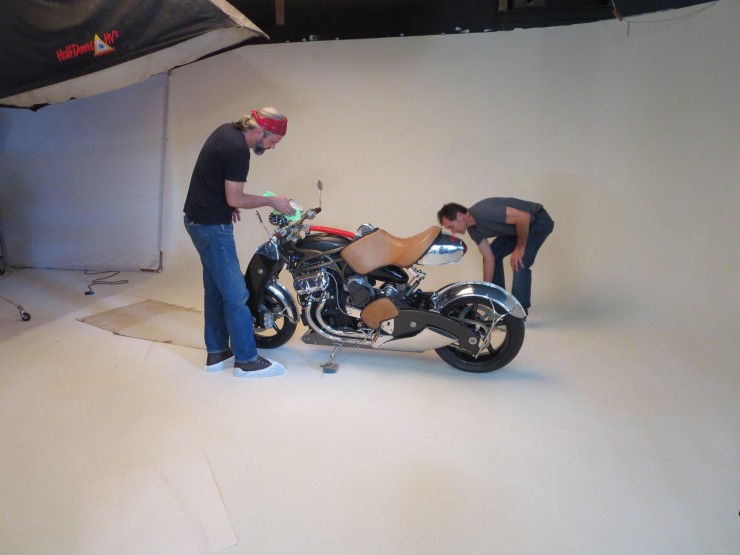
“Motorcycle culture has really been marginalized and still suffers from PTSD, having been virtually wiped out in the 70’s by the Japanese. I think that the near complete hegemony removed a lot of variety and cultural expression from the gene pool. The quality of the Japanese machines was better, but I don’t think that it was an equitable trade when one factors in the quality of people and ideas that were destroyed by the invasion. There is also a maturity in the automotive world that does not adhere to a morality based on money.
It’s like this, generally speaking: real car guys approach their passion as a wonderful salad of choices, and enjoy a personal relationship with the designers and engineers (individuals) who made it all possible, while motorcycle guys tend to self-identify with big corporations that make products. The humanity has been removed from the object.
A corollary – as a Fine Arts Major, I am a big fan of Rembrandt Van Rijn. When I am in the presence of his work, something wells up inside me and I am frequently moved to tears, but I have absolutely no need to own one of his works. The fact that I cannot afford to personally possess a canvass does not upset me in the least. I think that the world is a better place with him in it, and most car guys feel the same way about the masters of their craft. I don’t have to own a car by Horatio Pagani for it to make sense to me, for it to be an inspiration, an artefact, and a testament to the aspirations of humanity.”
Nesbitt has a simple litmus test to illustrate the divide – have a look at eBay motors, searching for all auto listings from highest price to lowest, then do again with the motorcycle listings. Compare and contrast what fetches top dollar in each category. Think about what we apparently value in each category (at least on eBay Motors, anyway).
Nesbitt has long been a proponent of high-minded ideals and intellectualism in an industry that can often seem anti-intellectual; something that has led to him being increasingly marginalized as he more vehemently defends his principles. Motorcycles are traditionally plebeian, blue collar devices. Their history is one of utility, cheap performance, and a tinge of outlaw culture keeping them just slightly out of the realm of respectability. It’s a reality that makes motorcycles accessible and appealing to many, but it often leads to a dumbing-down of the ideas surrounding bikes. They remain utilitarian, democratic devices. Commercial success often comes by abiding by the status quo – give the people what they want, which is almost always what they expect. Change is bad. Tradition reigns. Trying to rethink the design and conception of a motorcycle will generally net you a bunch of vicious commentary and a vocal reiteration of conservative tendencies. It is a reality Nesbitt is intimately familiar with.
“I will comment specifically on the American motorcycle industry… It is a poverty of the imagination, coupled with real lack of resources… In a word: degenerative. But from large companies, whose main focus is the mitigation of risk, what else would you expect?
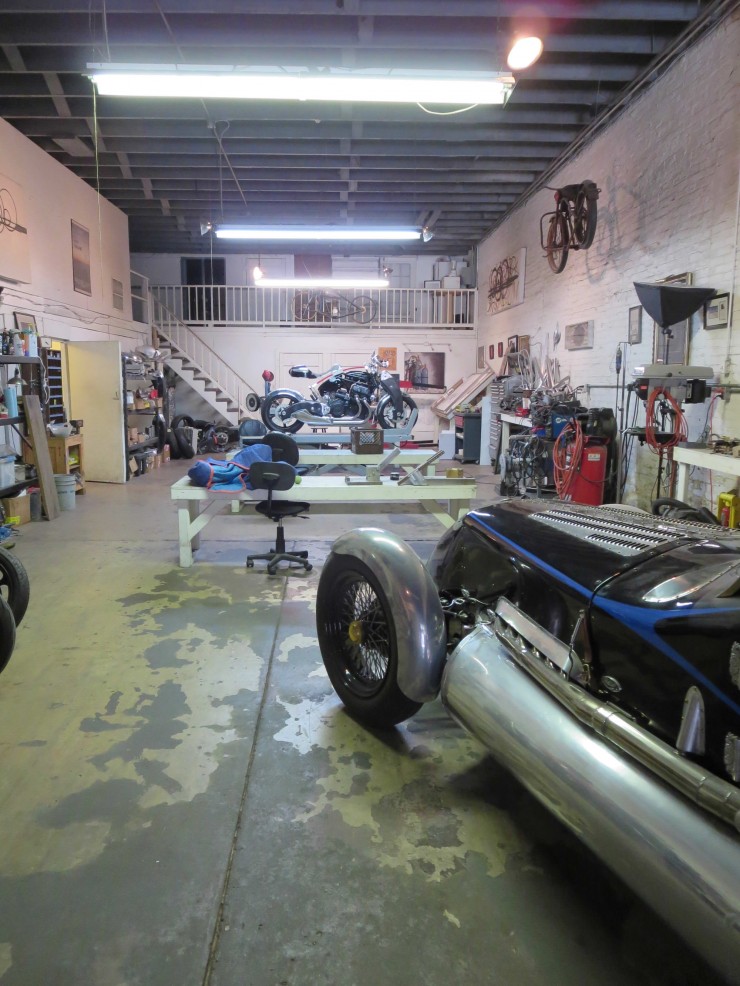
The real problem is the perception that the motorcycle MUST be an egalitarian exercise. This monetization and commercialization, has led to a race to the bottom. It’s almost Maoist, in its conformity. I think that this retro blue-collar dogma has stifled creativity. The idea that personal ownership of a motorcycle is the only avenue that justifies its value to culture is deeply flawed. This is the philosophy applied to the cars of the Soviet Union, and the results speak for themselves.
There are green shoots of hope, however. Of course I am a huge fan of Motus and Confederate (both here in the South, I might add) and for selfish reasons, as well as for the greater good, think that the lesson the 21st century is teaching us about innovation is that it comes from outside big industry.”
Nesbitt’s work at Bienville Studio is decidedly outside “big industry”, a diametric model to the likes of Harley-Davidson. It is a series of projects that have haemorrhaged funds to produced remarkable devices that cannot, by their nature, earn commercial success. Nesbitt’s refusal to compromise is what keeps him on the fringe of the motorcycle industry. His work is nearly impossible to commercialize, his business model nearly impossible to justify. But it is this methodology and set of uncompromising principles that drew Jim Jacoby of the American Design and Master-Craft Initiative to visit Nesbitt’s studio and discuss motorcycle design. It was this encounter and Nesbitt’s subsequent partnership with the ADMCi that led to the creation of the Bienville Legacy.
“What if there were a way to explore design without interference from the accounting and marketing departments? What if the stated goal was to experiment, to satisfy curiosity and remove the shackles of raw market driven capitalism?
I think that the greatest achievement of mankind is the Saturn 5 Rocket. Putting a man on the Moon is actually an outcome of the construction of the device itself, which was the result of collaboration between design engineers and master craftsmen. I challenge you to make a business case for that effort. It can’t be done. The spinoffs of that exercise, however, are all around us. The point is that sometimes doing things for the right reason would never get the blessing from our Harvard MBA holders who seem primarily interested in creating profitable positions for themselves. Corporate traditions of mining for talent within the American people are long gone. The nature of our government has changed as well. I mean, shit, we can’t seem to fix roads much less have any fun building cool stuff that isn’t directly related to weapons.
In this time of the highest concentration of wealth at the top, why are designers and master craftsmen disappearing from the social spectrum? Whose job is it to stop the loss? Is anybody even talking about this?
The American Design and Master-Craft Initiative seeks to find and fund underutilized human resources, and I cannot express how grateful I am to have been selected.
My little project is certainly no rocket to the moon, but there are a whole mess of engineering patents that have been generated, and the strange forms that the bike has taken as a result of ergonomic study that defies market expectations, may embolden others. Or it may not. The point is that the experiment took place, and I am so lucky to have had the opportunity to do it my way, for better or worse.”
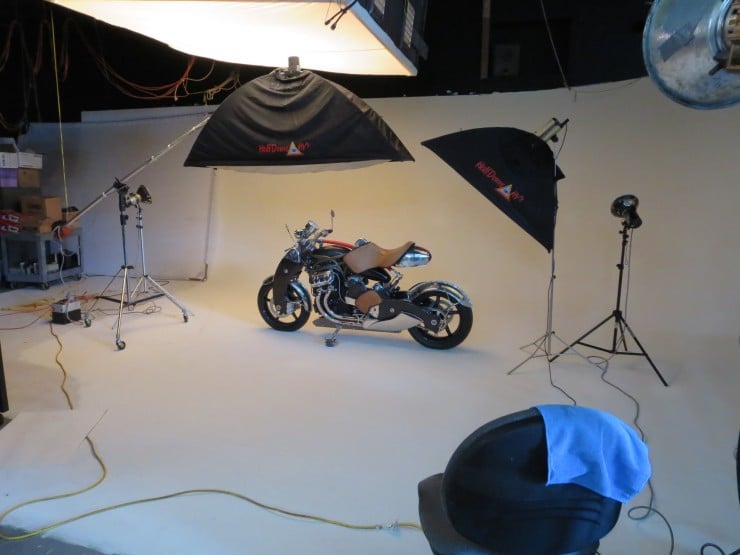
Jim Jacoby and the ADMCi
Nesbitt’s explanation glosses over some of the nuances of the partnership between the ADMCi and Bienville Studios. Jim Jacoby, founder of the ADMCi, elaborates on the foundation’s mandate and the broad aims of the Legacy project:
“The ADMCi is an initiative, which means it’s out for one thing first: strengthening a standard of excellence in master-craftsmanship throughout our lives. But, as an initiative, it is working to do a number of things concurrently, which can be a little confusing at first glance. For instance, we seek out, curate, and promote master-craftsmen in order to fund and study them. Doing this lets us translate what we learn into books, documentaries, and educational material. We’ve done exactly that with the Bienville project. We also collect and monetize the assets created in the commissions we undertake with master-craftsmen. So, for instance, the eight patents awarded during this project will be considered for sale, licensing with organizations that have bigger scale or need these innovations to strengthen their position in the market. The list goes on, but I’ll stop there. In short, we’re providing a bridge between living mentors and upcoming apprentices while working to fund our efforts based on a variety of the assets produced along the way.
The project is significant to the ADMCi for its place in master-craftsmanship first, not for the motorcycle industry, though we certainly start there as an entry-point for our audience. What we found, frankly, was that we gained a lot more than we’d bargained for in commissioning JT. In fact, we re-worked our understanding of the scale of mastery, adding the ‘grand-master craftsman’, which is where we would categorize him now. This simply means we’ve found a man who has achieved mastery over multiple media in order to achieve a master’s integrated result. It’s a level of ‘genius design’ that isn’t necessarily sustainable or even teachable, but is certainly worth celebrating. How many master leather workers, master welders, master electrical engineers, master mechanical engineers, etc. do you know? Now, how many do you know who can be found in one person. That’s what we have in this person and this project. To us, the outcome is far more a celebration of one man’s endurance, brilliance, and passion than it is the creation of a stunning bike. Of course, we love sharing the outcome in the bike as well!”
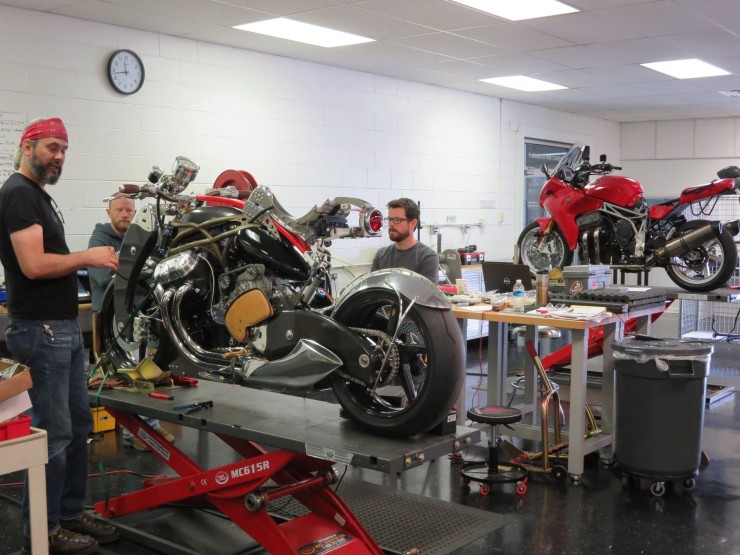
It begs the question – why fund an expensive project like this in the first place? What brought Jacoby to Nesbitt’s door, and what prompted him to take the risk of funding Nesbitt’s design?
“We funded the project because all the signs were there for a great outcome. We had a person who had achieved greatness once and didn’t have a clear path to achieve it again (situationally). He had a very clear vision for what he would produce if given the opportunity. And he had a very clear perspective on his role, which is not for financial gain but for impact on his industry and for the good of those receiving it. As we hold the assets today, we know JT has delivered 10-fold on the expected value we might have hoped for at the outset. No doubt, this man has set a high bar for future masters yet to be commissioned.”
The mutual benefits of the project, to both Nesbitt and the ADMCi, have proven to be an unexpected but remarkable outcome of the ADMCi’s involvement. The Legacy project was the first commission enacted by the foundation, and proved to be a high-profile entry that garnered more than its fair share of attention. It helped lay a foundation for sustainable growth of the program, contributing to future commissions and the betterment of the ADMCi’s educational arm.
“First and foremost the Legacy sets a standard for us. All of our commissions will be measured against the astounding outcomes from this one. Yes, we produced three extraordinary motorcycles, we sparked amazing conversation, had great fun and received appropriate returns from the objects created (have sold one so far). But we also have a clear path toward taking pre-orders on up to 9 more, which we’re doing now. We’re shopping rights to our publishing, documentary, and museum installations. We’re taking on sponsorship for a national salon-style speaking tour to spread the message of master-craftsmanship and in particular its impact on young men in our culture with major partners in publishing. Once again, the list goes on but I’ll stop here.”
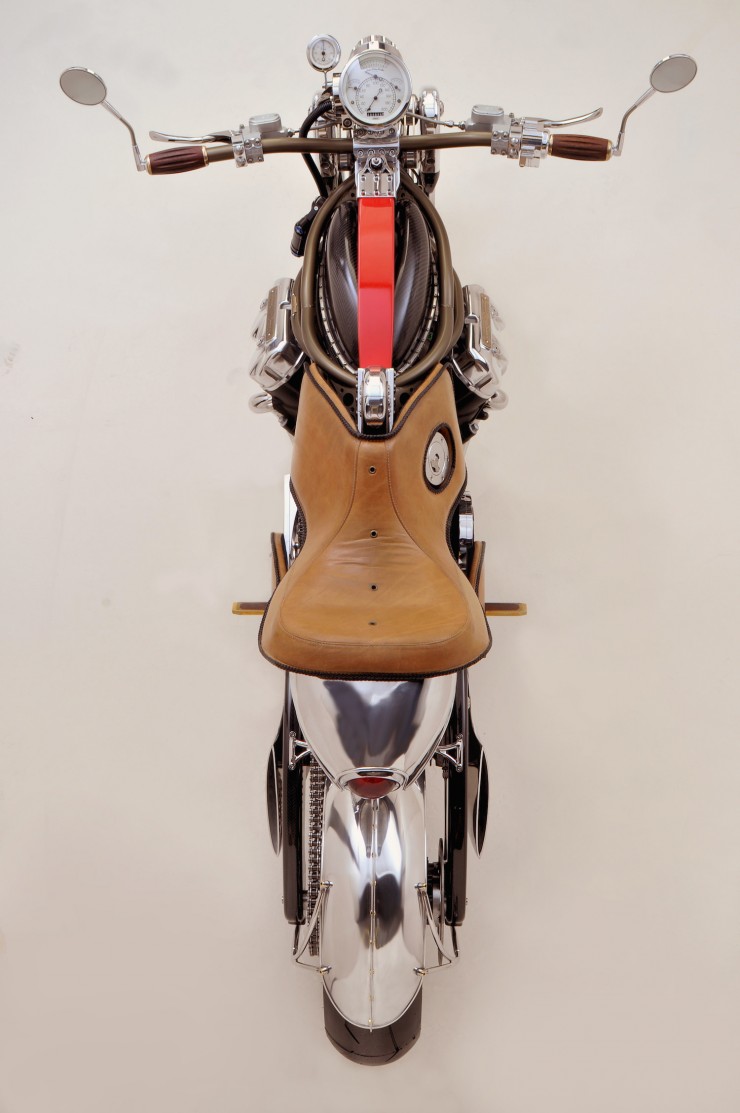
The Legacy Motorcycle Commission
The Legacy Motorcycle Commission, as the ADMCi refers to it, led to the production of three motorcycles – one for Jacoby, one for Nesbitt, and one for an anonymous buyer. Nesbitt built the three machines virtually single-handedly between April and October 2014. As Jacoby mentions, there is a possibility of the production of several more machines, thought Nesbitt is reluctant to ratify this prospect:
“The stated goal from day one was to make three. This required a large investment in high quality tooling, but I also wanted to incorporate as many hand-made pieces as possible. Another factor is the unlimited expense on materials. Most structural suspension components are titanium and carbon composite pieces. This mixture inherently limits the production capability. The thought of replacing any of these elements with cheaper and inferior replacements is not up for discussion.
I will say this: the NEED to make more is non-existent. The project has been fully funded with no remaining unsettled debt. All vendors have been made whole. All accounts are paid in full. The books are balanced and closed. There are no ongoing overhead costs, which means that only the DESIRE to make more would compel any further action.
The bill of materials, vendor list, supply chain, and intellectual property are codified and in place, and can be activated at any time.”
The ideas behind the Commission and the ADMCi, and the sustainable elements of the project, have been largely ignored by the media in their coverage of the Legacy. Exposure has been limited to curious sharing of what is an undeniably unusual machine with no context – no explanation as to how it came to be, or what it represents. Those that do take the time to investigate can be put off by Nesbitt’s high-minded ideals and passionate rhetoric. People seem to assume he is selling something, and they ain’t buying, immediately imposing a consumerist view and assuming there must be some commercial angle to his work. Somehow the very fact that these machines exist has made people angry, and inspired some spectacularly divisive and vicious commentary.
“Reaction to the Legacy has been shockingly negative… Venomous in fact. For three reasons I think… The first is pretty straightforward – assuming that people would take the time to read the original Design Brief and understand that the way the motorcycle looked reflected a departure from aesthetic norms in favor of ergonomic realities is, in hindsight, a big ask. The motorcycle is only complete with a rider mounted, and foolishly, I did not include a picture of a person astride. Guess my nose was a little too close to the chalkboard on that one.
The second is that this is a new suspension system that is a little hard to understand without actually seeing it in motion. The composite leaf actuated by a pull rod that is concentric with the steering neck is a totally new idea (rewarded with immediate acceptance by the USPTO). The goal for the suspension design was to solve inherent flaws in telescopic forks, save over-all weight, and reduce the number of component pieces by designing parts that multi-function…. not just make a crazy looking thing for emotional reasons. All decisions made are answers to engineering problems, but many of those engineering problems are entirely new…
The most interesting reaction however, is the false notion that I am asking the motorcycling public to validate this experiment by buying a motorcycle. I think that because this little corner of the world is so heavily commercialized, that the assumption was/is that I am asking for a sale. This is in fact a solipsistic project, and has no real need for external validation from the buying public. It exists whether it is loved or hated, which removes control from the consumer. A surprisingly antagonistic proposition as it turns out!
The other unexpected outcome has been nostalgia for the Wraith… Equally controversial upon its first unveiling ten years ago… Feel free to draw your own conclusions.”
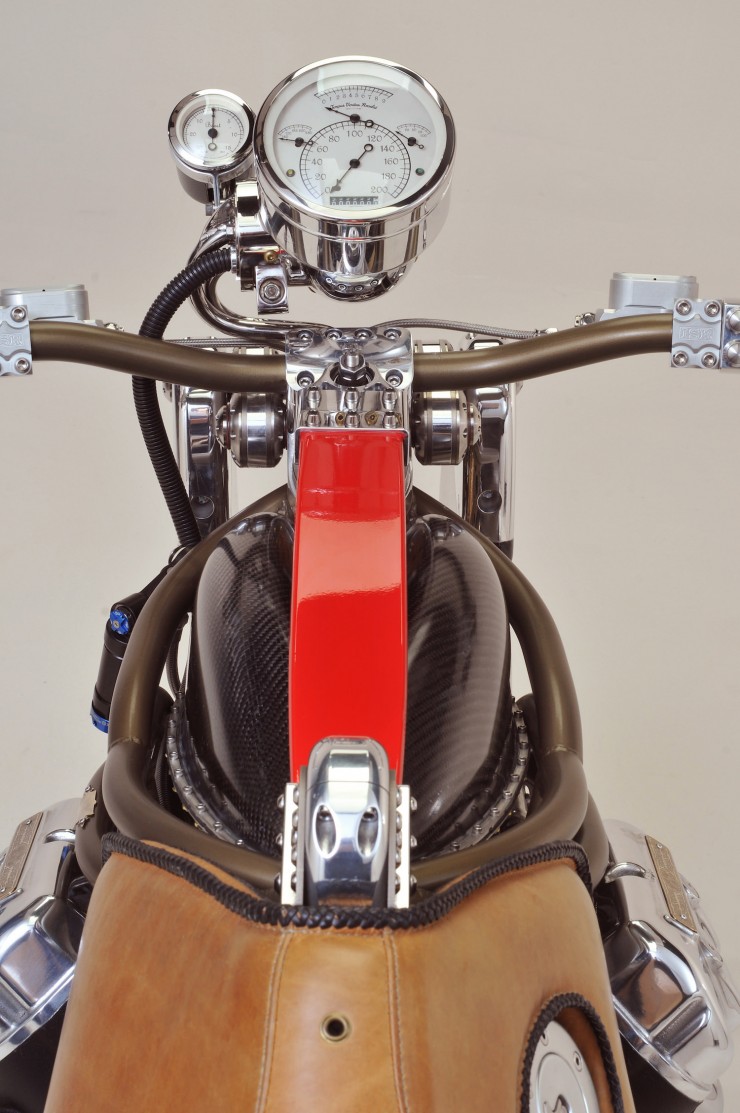
Jim Jacoby shared his own thoughts on the response to the Legacy:
“The project has had a poor response because we announced its physical completion to the audience hungriest to learn about it without helping them understand the context and meaning behind it. This was a known risk and one we wanted to take. It’s also an important moment to take in and remember as this initiative evolves. What will be the next divisive outcome and the next one? Will we, as a culture, eventually start to sit back and take in more information before lobbing short-sighted opinions? Well, ha, probably not entirely, but if some do, then we’re winning at the game we’ve chosen to play. That is, we’re here to elevate the conversation on the pursuit of excellence. The impact of that alone will be amazing for all of us.”
It’s a curious result, but one that isn’t that surprising. Attempts to rethink the design of the motorcycle have, historically, been met with derision and spite. It inspires the classic retort: “I wouldn’t buy that!”, as if personal ownership is the only thing that would validate the existence of a machine. Those few who praise new ideas tend to get drowned out by the contempt of the masses.
In any other industry Nesbitt’s work would be celebrated for its thought and intricacy. His cars inspired respect and awe. He continues to get a constant stream of inquiries for his modernized LeMat revolver, even though he has no intention of producing it. If he were a watchmaker his uncompromising ideals, his penchant for unusual design, and his remarkable skills as a craftsman would put him at the top of the game.
But here, in this industry, he is beaten down, insulted, and marginalized. Why?
JT Nesbitt isn’t fighting you, the Average Motorcyclist. He is fighting complacency in an industry that he holds dear. Nesbitt isn’t trying to sell you one of his motorcycles. The only thing he is selling is his ideas and his hopes to inspire something new in an industry that has thrived on stagnation and nostalgia.
The truth is Nesbitt is an astonishingly perceptive and intelligent designer. He had no delusions of mass production or acceptance by manufacturers or consumers. This is hard to convey to people who have never met JT, or had the opportunity to speak with him candidly. On paper he can seem bombastic and confrontational. While he can often be blunt, this is a direct result of his honesty and his uncompromising passion. He truly believes in what he is doing, and his resolve is infectious. He desperately wants to instigate critical thinking about this industry and the state of American design and manufacturing. He is keen to hear constructive criticism about his Legacy design, using his work to inspire a dialogue about the design and engineering of motorcycles in general, but so far no has taken him to task (insulting, unproductive griping aside).
The Legacy Motorcycle Commission is nearly complete, but the motorcycles are not quite finished. A considerable amount of work remains to be done before the three Legacies will be road worthy, at which point Jacoby’s personal machine (outfitted with a centrifugal supercharger) will be taken to the Bonneville Salt Flats for a record run. While the chassis and running gear of the three machines are complete, save for some final suspension adjustments, the engines are not yet ready to run. The Motus “baby block” V4 powerplants use a proprietary wiring harness that needs to be adapted to the Legacy’s electrical system; Nesbitt and the team at Motus have been collaborating to finish the wiring harness and get the engines running. After that, tuning work will be required to get Jacoby’s supercharged machine ready for the Flats. Nesbitt remains busy at work finishing the final details of the three Legacies in his New Orleans studio.
“A huge project like this requires so many people. If it is to be said that I have any talent, it is the ability to select and surround myself with people that are masters of their specific crafts. It is so much more than merely establishing a supply chain and tight vendor list. My friends gave time and talent on a level that would restore even the most cynical.
For someone without the quality of human resources that I have been fortunate enough to cultivate, the cost would have been prohibitive. I have relied on the strength of lifelong partnerships to make this happen.
Jim Jacoby of the ADMCi selected my project, and funded it.
Scott Tudury was the lead design engineer and machinist.
Tim George engineered the worm-gear drives and constructed coachwork.
David McMahon rendered CAD and solved production chassis fabrication.
Gary Turner masterfully executed the structural composites.
David Czarnecki rendered the front suspension files.
Max Mcallister tuned the suspension.
Alan Kirkfield applied all specialty coatings and paint.
Dwayne Dufechou engineered countless water jet pieces.
Aaron Breaux was the master fabrication consultant.
Marc Bondarenko produced the fantastic studio photography shown here.
And of course Brian Case… Without his engine, and friendship, this project would lack meaning.
There are many others, and it is my hope that they will use their time here in the studio, and my admiration, as reference material for future endeavors, reflecting on the experience with pride, and capitalizing on it at every opportunity.”
See more from Bienville Studios here.
Interview by Jason Cormier of Odd Bike.
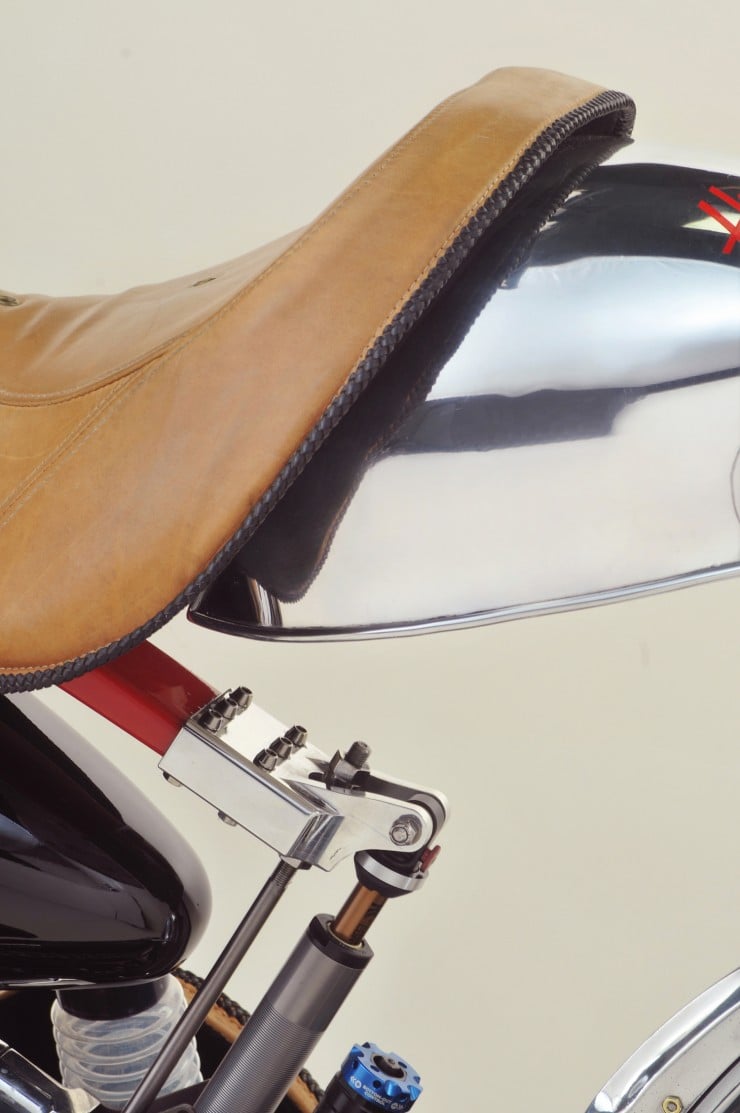
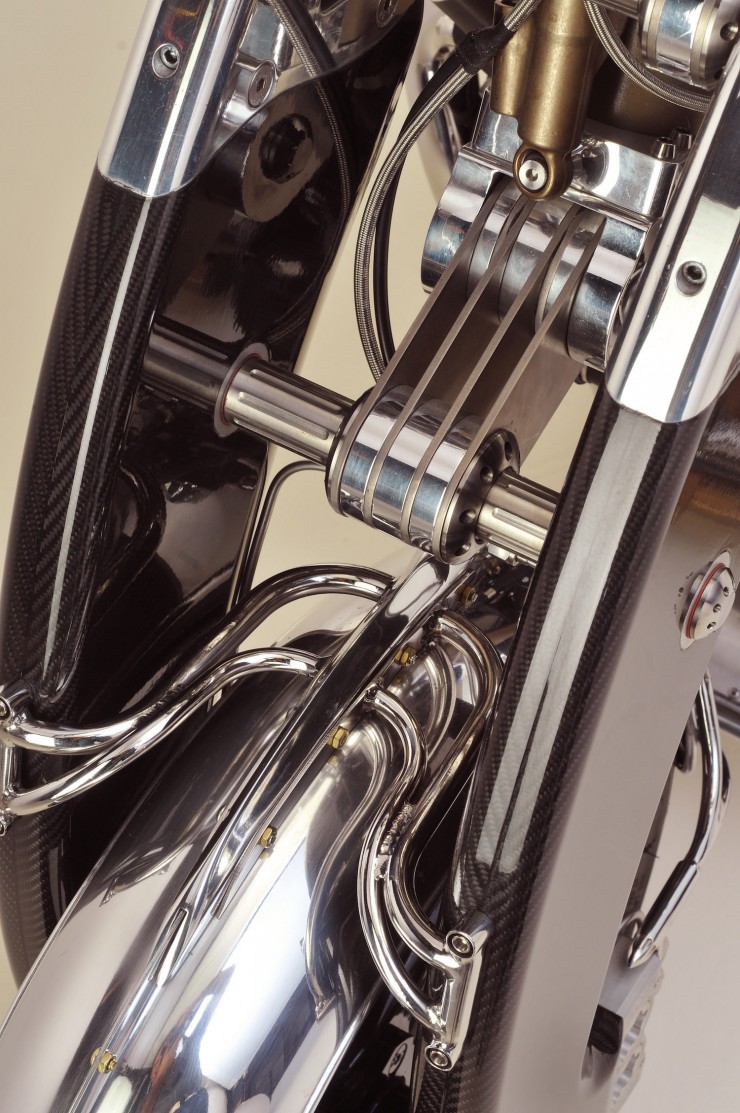
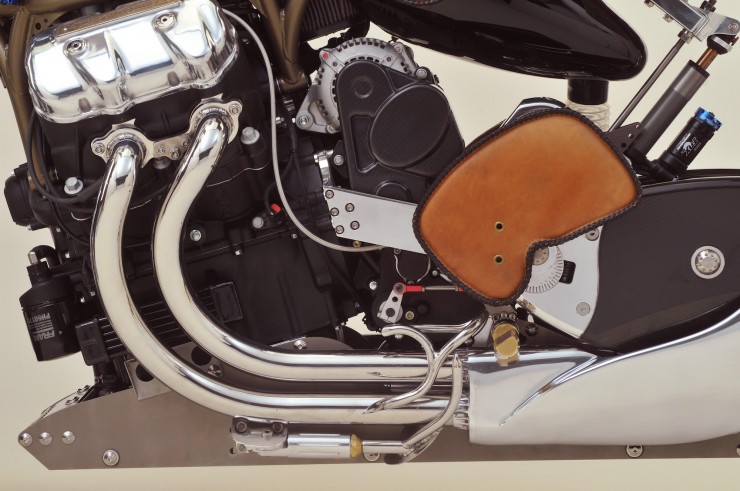
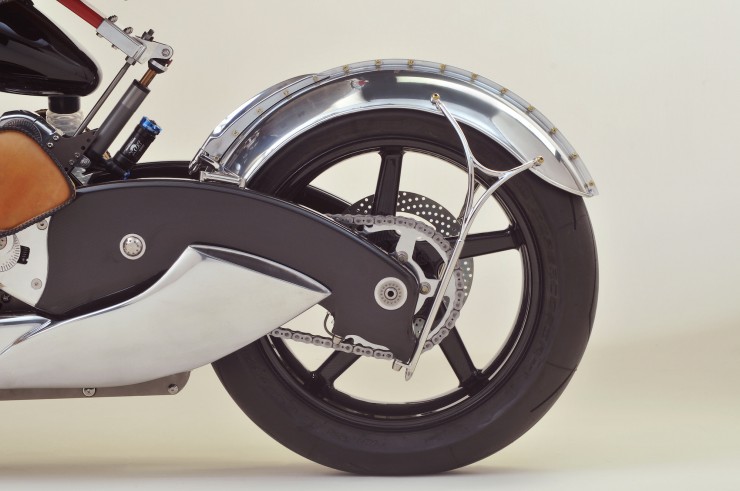
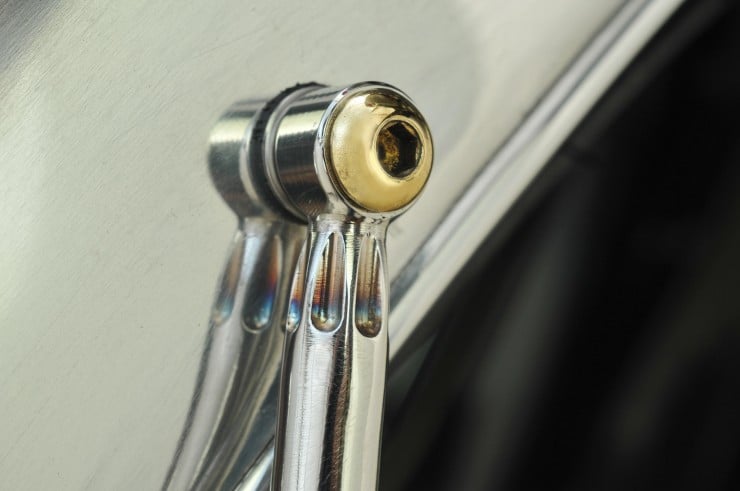
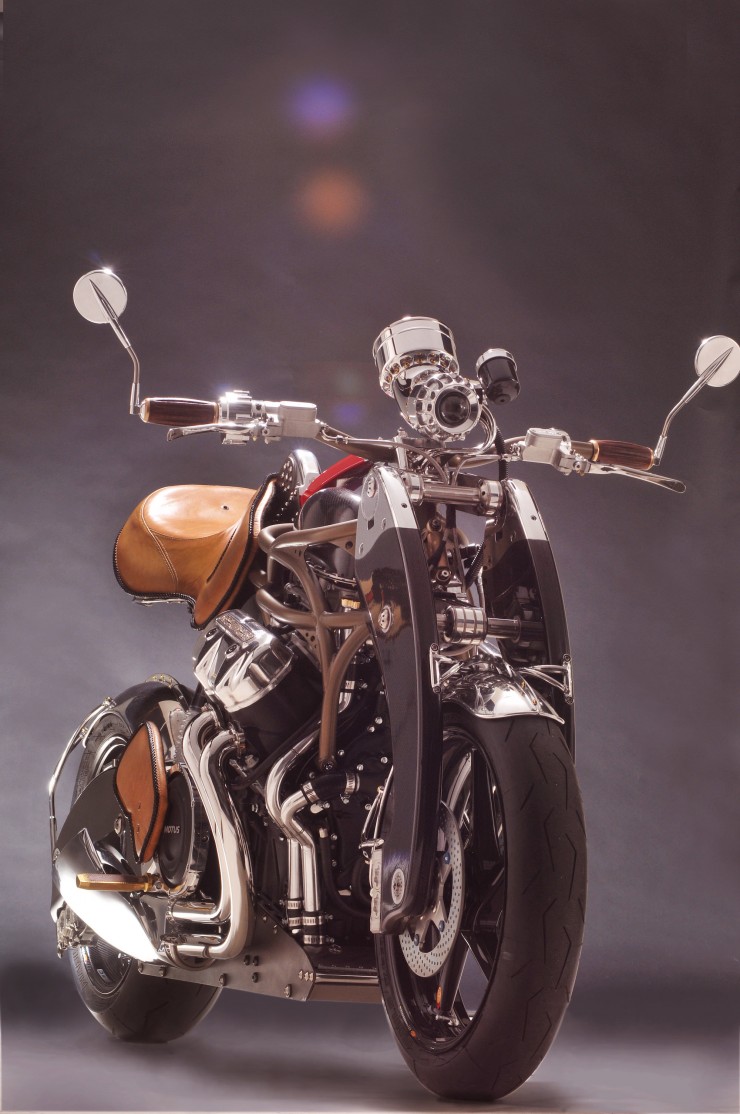
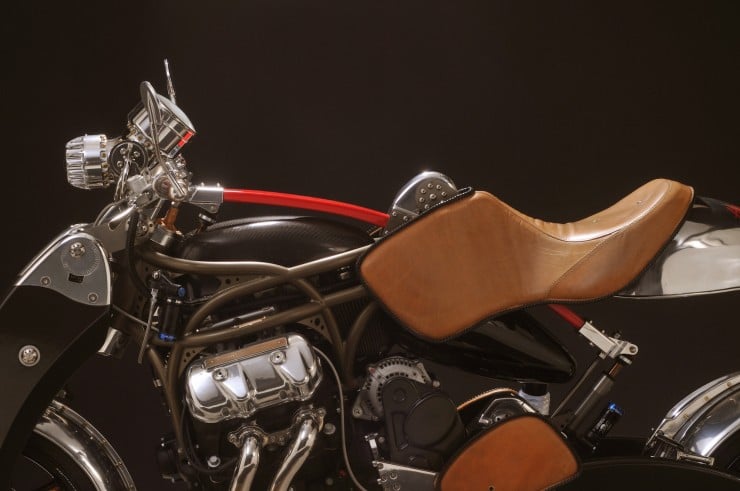
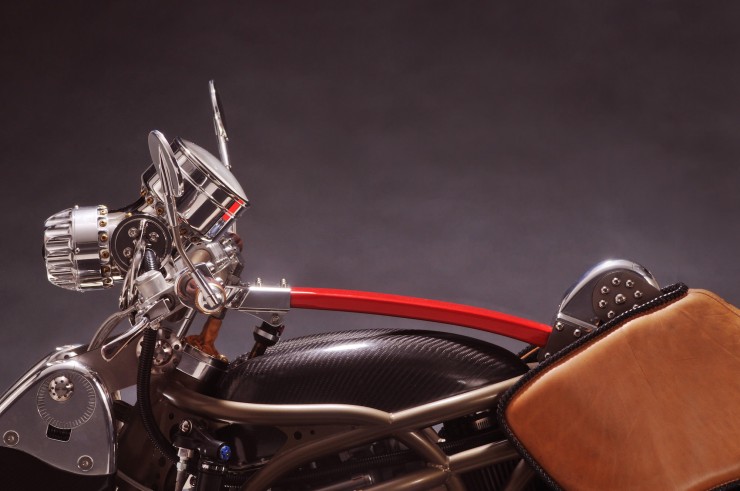

Articles that Ben has written have been covered on CNN, Popular Mechanics, Smithsonian Magazine, Road & Track Magazine, the official Pinterest blog, the official eBay Motors blog, BuzzFeed, Autoweek Magazine, Wired Magazine, Autoblog, Gear Patrol, Jalopnik, The Verge, and many more.
Silodrome was founded by Ben back in 2010, in the years since the site has grown to become a world leader in the alternative and vintage motoring sector, with well over a million monthly readers from around the world and many hundreds of thousands of followers on social media.

